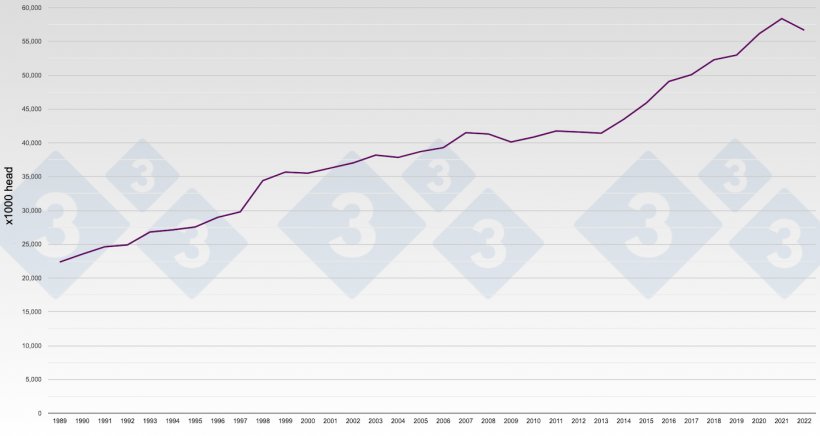At the end of the 1990s, the Spanish swine industry as a whole was at a crossroads: Should it continue to grow in a kind of endless race, or was it better to proceed more carefully? Practically everyone opted to grow and "see what would happen".
In the year 2000, the total number of pigs slaughtered in Spain was 35,500,000 head.

In 2000, the first clear sign of vertical integration of pig production appeared: the largest Spanish integrator group bought the leading slaughterhouse in the Osona region of Barcelona. This started the industry on a path with no return.
From June 2001 to May 2002, several outbreaks of classical swine fever occurred in Spain. The pig price suffered and remained below 1.00 €/kg live for months. This crisis caused some important farmers to go out of business.
Life went on and growth continued once this outbreak of CSF was over. In 2008 China approved a number of Spanish slaughterhouses as suppliers of pork (although the first shipments did not materialize until 2009), thus beginning a remarkable story.
If we recall that in 1989 Spain slaughtered 29,000,000 pigs and we know that in 2021 it reached the astonishing record figure of 58,600,000, we must inevitably deduce that exports have absorbed all of this increase. Indeed, this has been the case.

Graph 1. Evolution of pig production in Spain. Number of pigs slaughtered per year.
If we were to ask ourselves what the reasons are for this fabulous increase (102% in 33 years) the answer is quite simple: finishing pigs in Spain has been good business (otherwise it would not have grown: obvious truism). With continuous losses, one either decreases or disappears.
We must mention that parallel to the growth of the herd in Spain, there has been a clear increase in slaughter capacity. These two increases have not been identical, but they have been close. Currently, no one doubts that the available slaughter capacity in Spain far exceeds the supply of animals for slaughter at any time of the year.
Over time we have seen many industrial operators disappear (including the two leading companies in Spain in the 1990s with more than 20,000 pigs processed per week) as well as an unstoppable concentration: there are fewer and fewer operators and they are getting bigger and bigger.
ASF in China acted as a positive catalyst for the Spanish swine business: exports to China exploded and Spain became China's leading supplier of pork. Quite an achievement.
Currently, five integrators with slaughter and cutting operations control slightly less than 50% of the Spanish herd. We have arrived here and this is how we are. And there is no doubt that this concentration will continue as a logical consequence of the implacability of the market. Globalization is a fact and the Spanish swine industry is not left out. The trend is fewer and increasingly larger operators. Whether we like it or not.
There is currently a general consensus about the difficulties of managing a Spanish slaughterhouse without its own pig herd.
We know that there are staggering herd reductions in the EU (of around 14% in some countries) and that these reductions have the appearance of being structural (abandoned farms that are unlikely to go back into production, farmers without succession...). We know that in Spain the significant reduction observed so far this year (about 8-9% less slaughter than the previous year) is circumstantial and mostly due to the virulence of PRRS. It seems obvious to us that Spanish pork is called upon to fill the gaps that the absence of pigs in other countries is causing within the European borders.
Spain will increase its intra-EU exports (this is already happening) while decreasing exports to third countries. This is inevitable.
This current situation and the short-term future - which is already on the horizon - may be seriously affected by the arrival of ASF in Spain (providence forbid). If this were to happen, it would be a historic disaster, one that would be epoch-making and leave a mark on the protagonists. In this hypothetical case, the problem would be in the pig farming sector, which would bear the brunt of the enormous economic damage that would result from this misfortune. Let's keep our fingers crossed.

As the readers know, the pig price in Spain is set by the most important pig market in the Iberian Peninsula: Mercolleida. Mercolleida has faithfully and perfectly fulfilled its role of setting the price of Spanish pigs for more than 50 years now. Essentially, it is a table where the slaughterhouses are represented on the one side and the pig farmers on the other. Over the years, as we have mentioned, the dividing line between the two has become blurred, as there are farmers who slaughter and butcher many pigs and slaughterhouses that have a large number of livestock. We will see what the future holds for this market.
Finally, a few telegraphic notes on current events:
- Two Spanish slaughterhouses have recently closed down. There is a general consensus among significant operators that further closures will occur before the end of the year.
- Major Spanish meat processors have presented their 2022 balance sheets with significant losses.
- The four months that Spain had the highest pig prices in the world have caused significant difficulties and will leave persistent after-effects.
We are at a critical moment in the history of the Spanish swine industry. To date, it has been a success story. In a world governed by liberal capitalism, the laws of the market are implacable: the less strong falter first and are pushed aside.
Guillem Burset




